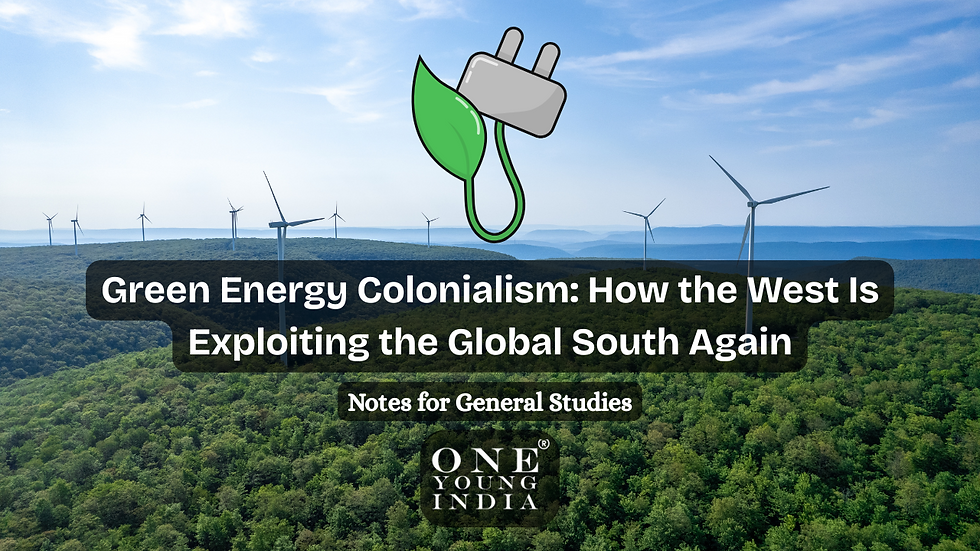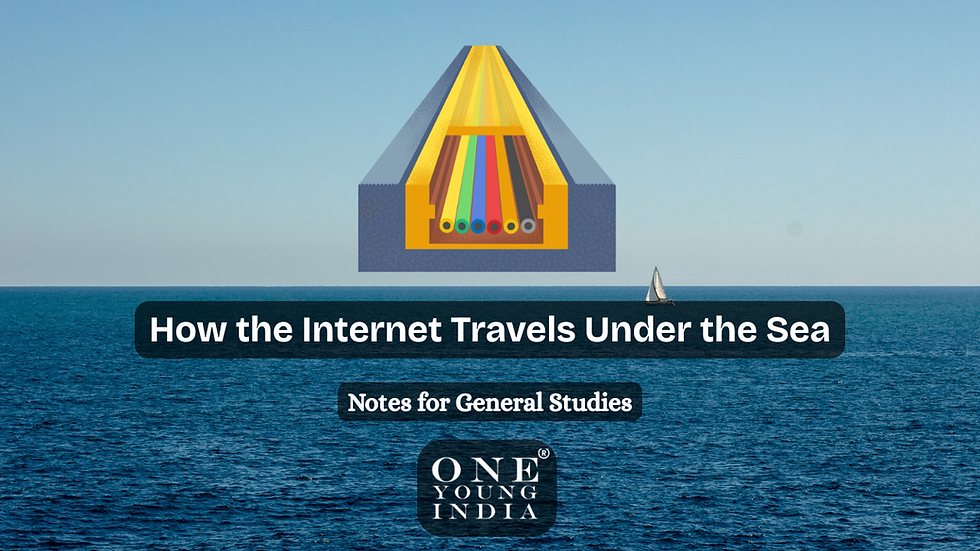Green Energy Colonialism: How the West Is Exploiting the Global South Again
- One Young India

- Aug 12
- 5 min read
1. Introduction: A Green Revolution with a Dark Underside
In the 21st century, the global conversation around energy has shifted dramatically. The urgent need to reduce carbon emissions, combat climate change, and move away from fossil fuels has given rise to what many call the Green Revolution. Solar farms stretch across deserts, wind turbines spin across coastlines, and battery-powered cars are fast becoming the norm in developed nations.

But beneath the glossy headlines and grand promises lies a complex and troubling truth: this new green wave is not as equitable as it appears. While the West celebrates its “clean” future, it often overlooks the fact that much of its progress depends on exploiting the Global South—regions rich in natural resources but politically and economically disadvantaged.
This dynamic has given birth to what experts increasingly refer to as “Green Energy Colonialism.” Just as historical colonial powers extracted gold, cotton, and spices, modern green economies extract cobalt, lithium, rare earth minerals, and cheap labor from the developing world—often with devastating environmental, social, and political consequences.
2. Defining Green Energy Colonialism
At its core, Green Energy Colonialism refers to the uneven power dynamics in the global green economy. While the West positions itself as the leader in renewable energy innovation, it relies heavily on the extraction of critical raw materials from poorer nations—often under exploitative or environmentally harmful conditions.
Instead of fostering sustainable partnerships, the West frequently prioritizes securing supply chains over ensuring fair trade, just wages, and environmental protection. The result? Developing nations bear the ecological cost while developed nations reap the clean-energy rewards.
It’s not unlike the colonial era—only this time, the ships carry lithium instead of spices, and the empires are corporations and governments wrapped in the language of sustainability.
3. Historical Parallels: Old Patterns in a New Era
History is repeating itself—only the commodities have changed.
Colonial Era: European powers extracted raw materials from Africa, Asia, and Latin America to fuel their industrial revolutions.
Today: The same regions are being mined for the building blocks of the green economy—minerals like cobalt from the Democratic Republic of Congo, lithium from Bolivia and Chile, and rare earth metals from Madagascar.
What’s striking is the similarity in power asymmetry. Then and now, the Global South provides raw materials but sees little in return. Local communities often face displacement, land degradation, and economic dependency, while profits flow outward.
4. The Raw Material Race: Who Holds the Resources?
To understand this dynamic, we need to look at where the world’s green resources are located:
Cobalt: Over 70% of the world’s cobalt comes from the Democratic Republic of Congo (DRC). Cobalt is crucial for batteries used in electric vehicles (EVs) and renewable energy storage systems.
Lithium: Known as “white gold,” lithium is concentrated in the Lithium Triangle—Chile, Argentina, and Bolivia—which holds more than half of the world’s known reserves.
Rare Earth Elements: China dominates the refining process, but deposits are spread across Africa, South America, and Southeast Asia.
Nickel & Copper: Key for battery tech and grid infrastructure, with major deposits in Indonesia, the Philippines, and Zambia.
The geopolitical importance of these resources cannot be overstated. Countries rich in these minerals are finding themselves at the center of a new global scramble for resources—only this time, the justification is fighting climate change.
5. Environmental and Social Costs
While renewable energy aims to reduce environmental harm, the mining of green resources can be anything but green. In the DRC, cobalt mining has been linked to toxic pollution, deforestation, and contaminated water sources. Lithium extraction in Chile’s Atacama Desert consumes vast amounts of water, devastating local ecosystems and threatening indigenous livelihoods.
Social costs are equally alarming:
Child labor remains widespread in artisanal mining operations in Africa.
Land grabs displace indigenous communities without adequate compensation.
Political instability is often fueled by resource wealth, leading to corruption and even armed conflict.
Ironically, in the rush to save the planet, many green energy projects reproduce the very exploitation and inequality that fossil fuel extraction was infamous for.
6. The West’s “Clean Image” vs. the Global South’s Reality
In Western capitals, electric cars, solar panels, and wind farms are hailed as symbols of progress. Governments boast about reducing emissions and meeting Paris Agreement targets. But these achievements often mask the fact that the carbon footprint is simply outsourced.
For example:
When cobalt is mined in unsafe conditions in the DRC and shipped to Europe for EV production, the environmental and social damages remain in the DRC, while Europe counts the finished EV as “clean.”
When lithium extraction dries up local water supplies in South America, the resulting social unrest doesn’t appear in Western climate progress reports.
This creates a two-tiered climate policy—a clean, green West and an exploited, polluted South.
7. Why the Global South Has Limited Bargaining Power
One might ask: Why don’t resource-rich nations simply demand fairer deals?
The answer lies in several structural challenges:
Debt dependency: Many countries are burdened with foreign debt and rely on export earnings to service it.
Lack of technology: Resource-rich countries often lack the infrastructure to process and refine minerals, forcing them to export raw materials at low prices.
Global market pressures: Prices are often dictated by international commodity markets dominated by powerful corporations.
Political instability: Corruption and governance issues weaken negotiating positions.
This imbalance ensures that the profits of the green revolution flow disproportionately to already wealthy nations.
8. Greenwashing and Corporate Responsibility
A troubling aspect of green energy colonialism is greenwashing—when corporations market themselves as environmentally friendly while ignoring or downplaying their exploitative supply chains.
Multinational companies often release glossy sustainability reports and commit to “ethical sourcing,” but investigative journalism has repeatedly shown that supply chain audits can be shallow, incomplete, or manipulated.
Without binding international regulations, corporate responsibility remains largely voluntary—and voluntary commitments rarely challenge profit motives.
9. Possible Alternatives: Can Green Energy Be Truly Just?
To move beyond green energy colonialism, several solutions have been proposed:
9.1 Strengthening Local Economies
Countries in the Global South should invest in downstream industries—such as refining, battery production, and tech manufacturing—so they capture more value from their resources.
9.2 International Regulations
Global agreements could enforce labor rights, environmental safeguards, and fair trade practices across green supply chains.
9.3 Technology Transfer
The West can share green tech expertise, enabling resource-rich nations to develop their own renewable energy industries rather than merely exporting raw materials.
9.4 Diversifying Energy Sources
By investing in multiple energy technologies—solar, wind, hydro, nuclear—countries can reduce dependency on a small set of minerals, thus reducing pressure on specific regions.
10. The Role of India and Other Emerging Economies
India, Brazil, South Africa, and other emerging economies occupy a unique position. They are both victims and participants in the green energy race. India, for instance, imports lithium and cobalt but also aspires to become a global hub for EV manufacturing.
Emerging economies can push for South-South cooperation—forming alliances that negotiate better terms collectively, rather than competing individually for Western contracts.
11. Conclusion: A Truly Green Future Must Be Just
If the fight against climate change reproduces the exploitation of the past, then we are not witnessing a revolution—we are witnessing a rebranding. The green economy must be built not only on clean energy but also on clean ethics.
A truly sustainable future will require dismantling the extractive power structures of old and ensuring that the benefits of the green revolution are shared equitably. Without this, green energy risks becoming just another chapter in the centuries-long story of global inequality—one painted in the color of hope but built on the same old foundations of exploitation.



